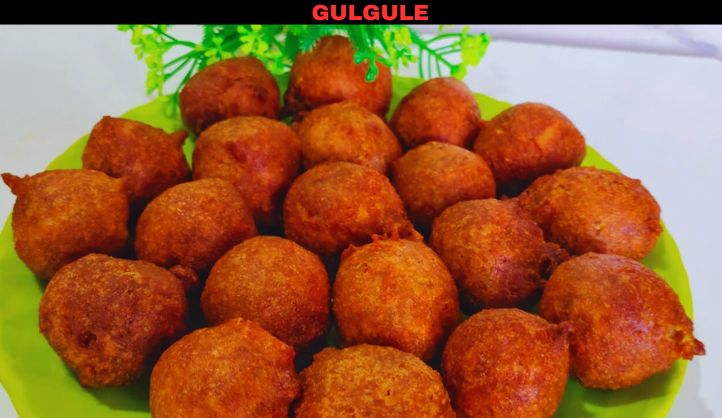Nestled amidst the majestic Himalayas, Uttarakhand is not only blessed with breathtaking natural beauty but also a rich culinary tradition that reflects the region’s vibrant culture. Among the many delightful delicacies that grace the tables of Uttarakhandi households is the beloved Gulgule—a sweet treat that encapsulates the essence of warmth, simplicity, and tradition. Join me as we embark on a journey to discover the delightful world of Gulgule and its significance in Uttarakhandi cuisine.
Origins and Significance
Gulgule, also known as Pua or Pude, holds a special place in the hearts and palates of the people of Uttarakhand. With its origins deeply rooted in local customs and festivities, Gulgule is often prepared during auspicious occasions, festivals, and family gatherings. It’s not just a dessert but a symbol of celebration and togetherness, where generations come together to create sweet memories around the kitchen hearth.
Ingredients
The beauty of Gulgule lies in its simplicity, with basic ingredients readily available in any Uttarakhandi kitchen. Here’s what you’ll typically find in a traditional Gulgule recipe
1. Wheat Flour – The main ingredient, providing the base for the batter and imparting a wholesome flavor.
2. Jaggery (Gur) or Sugar – Sweetens the batter and adds a caramel-like richness to the Gulgule.
3. Fennel Seeds (Saunf) and Cardamom Powder – Infuses aromatic flavors into the Gulgule, enhancing its taste and fragrance.
4. Baking Powder – This helps the Gulgule achieve a light and fluffy texture when fried.
5. Water or Milk – Used to make a smooth batter consistency.
Preparation
Making Gulgule is a relatively simple process, yet it requires a touch of finesse to achieve the perfect balance of flavors and textures. Here’s a step-by-step guide to preparing this delightful sweet
- In a mixing bowl, combine the wheat flour, jaggery or sugar, fennel seeds, cardamom powder, and baking powder.
- Gradually add water or milk to the dry ingredients and mix well until a smooth batter is formed. The consistency should be thick enough to coat the back of a spoon.
- Heat oil in a deep frying pan or kadhai over medium heat.
- Once the oil is hot, carefully drop spoonfuls of the batter into the oil using a spoon or your fingers. Fry the Gulgule in batches, making sure not to overcrowd the pan.
- Fry the Gulgule until they turn golden brown and crispy on the outside, and are cooked through on the inside.
- Remove the fried Gulgule from the oil using a slotted spoon and drain the excess oil on paper towels.
- Serve hot or at room temperature, garnished with chopped nuts or a sprinkle of powdered sugar if desired.
Flavors and Variations
What sets Gulgule apart is its delightful combination of flavors—sweet, fragrant, and subtly spiced. The earthy sweetness of jaggery or sugar, combined with the aromatic notes of fennel seeds and cardamom, creates a harmonious symphony of taste that is both comforting and indulgent. Additionally, Gulgule can be customized to suit individual preferences by adjusting the sweetness level or adding other ingredients like grated coconut, mashed bananas, or chopped nuts for added texture and flavor.
Health Benefits
While this is undeniably a sweet indulgence, it does offer some nutritional benefits, especially when made with wholesome ingredients like whole wheat flour and natural sweeteners. Whole wheat flour provides fiber, vitamins, and minerals, while jaggery offers iron, calcium, and other micronutrients. However, like any fried sweet, this should be enjoyed in moderation as part of a balanced diet.
Exploring the Cultural Significance
Beyond its delicious taste and simple preparation, Gulgule holds deep cultural significance in Uttarakhand. It is not just a sweet dish but a symbol of community and celebration. In Uttarakhandi households, making Gulgule is often a communal affair, with family members coming together to prepare the batter, fry the Gulgule, and share stories and laughter around the kitchen. The aroma of frying Gulgule wafting through the air is enough to bring everyone together, creating cherished memories that last a lifetime.
Seasonal Celebrations
This is especially popular during festivals and seasonal celebrations in Uttarakhand. Whether it’s the joyous occasion of Diwali, the harvest festival of Holi, or the auspicious days of Navratri, Gulgule finds its place on the festive platter, symbolizing prosperity, happiness, and abundance. It’s also a common offering to deities during prayers and rituals, signifying devotion and gratitude towards the divine.
Sharing Sweet Moments
One of the most beautiful aspects of Gulgule is its ability to bring people together and create moments of sweetness in everyday life. Whether it’s served as a treat for guests, shared among friends over a cup of tea, or enjoyed with loved ones on a lazy Sunday afternoon, Gulgule fosters a sense of connection and camaraderie that transcends barriers of age, gender, and social status.
Preserving Tradition
As Uttarakhand undergoes rapid modernization and cultural shifts, dishes like Gulgule play a crucial role in preserving the region’s culinary heritage and traditional practices. Passing down recipes from generation to generation ensures that the flavors and rituals associated with Gulgule continue to thrive, keeping alive the spirit of Uttarakhandi culture for years to come.
Other Famous Dishes of Uttarakhand
Bal Mithai
A famous sweet from Uttarakhand, Bal Mithai is made from khoya (reduced milk) rolled into small balls and coated with white sugar balls known as “palm.” It’s then garnished with chopped nuts like almonds or pistachios, creating a unique and indulgent treat.
Singodi
Singodi, also known as Singauri or Singodi Barfi, is a traditional sweet made from grated coconut, khoya (reduced milk), and sugar. The mixture is wrapped in leaves from the Malu tree and allowed to set, imparting a subtle earthy flavor to the sweet.
Phaanu
Phaanu is a nutritious dish made from a variety of lentils, including whole urad dal and rice, soaked overnight and then ground into a coarse paste. The paste is then cooked with garlic, ginger, and spices to create a thick and creamy stew-like consistency, often enjoyed with rice or millet bread.
Jhangore Ki Kheer
Jhangore, also known as barnyard millet, is a staple grain in Uttarakhand. Jhangore Ki Kheer is a sweet pudding made by cooking jhangore with milk, sugar, and aromatic spices like cardamom and saffron.
Dubuk
Dubuk is a hearty soup made from mixed lentils, vegetables, and grains like barley or buckwheat. It’s flavored with local herbs and spices, making it a nutritious and warming dish, especially during the cold winter months.
Arsa
Arsa is a traditional sweet made from rice flour, jaggery, and ghee. The mixture is deep-fried until golden brown and crispy, resulting in a delicious sweet treat that is often enjoyed during festivals and celebrations.
Conclusion
It epitomizes the spirit of Uttarakhandi cuisine—simple, rustic, and brimming with warmth and flavor. Whether enjoyed as a festive treat, a comforting snack, or a sweet indulgence on a lazy afternoon, it brings joy to both the maker and the eater, weaving together the threads of tradition and togetherness. So, the next time you’re craving a taste of Uttarakhand’s culinary heritage, why not whip up a batch of Gulgule and savor the sweet flavors of tradition?
FAQs About Gulgule
What is Gulgule?
Gulgule, also known as Pua or Pude, is a traditional sweet dish from Uttarakhand, India. It is made from a batter consisting of wheat flour, jaggery or sugar, fennel seeds, cardamom powder, and baking powder, which is deep-fried until golden brown and crispy. it is often enjoyed as a festive treat or snack, symbolizing celebration, togetherness, and the rich culinary heritage of Uttarakhand.
What are the main ingredients in Gulgule?
The main ingredients in Gulgule include wheat flour, jaggery or sugar, fennel seeds, cardamom powder, baking powder, and water or milk. These simple and readily available ingredients come together to create a delightful sweet dish that is cherished in Uttarakhandi households.
How is Gulgule traditionally served?
Gulgule is traditionally served as a sweet treat during festivals, celebrations, and family gatherings in Uttarakhand. It can be enjoyed hot or at room temperature, often garnished with chopped nuts or a sprinkle of powdered sugar. It pairs well with a cup of tea or as a dessert after a meal.
Can I make Gulgule without jaggery?
Yes, Gulgule can be made with either jaggery or sugar, depending on personal preference and availability of ingredients. While jaggery adds a rich caramel-like flavor to the dish, sugar can be used as a substitute to achieve sweetness. The choice of sweetener may alter the flavor slightly but will still result in a delicious dish.
Is Gulgule gluten-free?
Gulgule is typically not gluten-free, as it is made from wheat flour, which contains gluten. However, gluten-free variations can be made by using alternative flour such as rice flour or chickpea flour. Additionally, individuals with gluten sensitivities or allergies should ensure that all ingredients used are free from gluten contamination.





